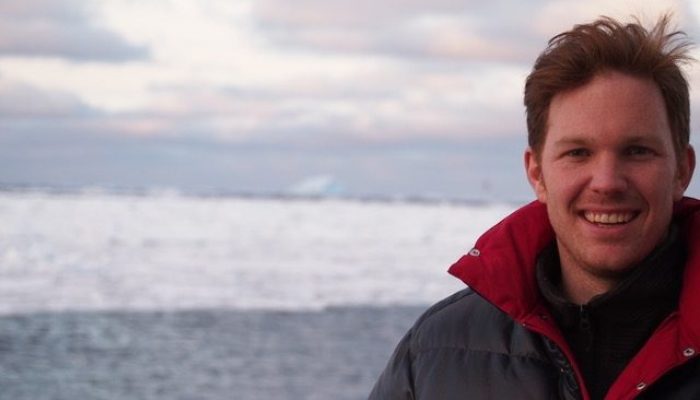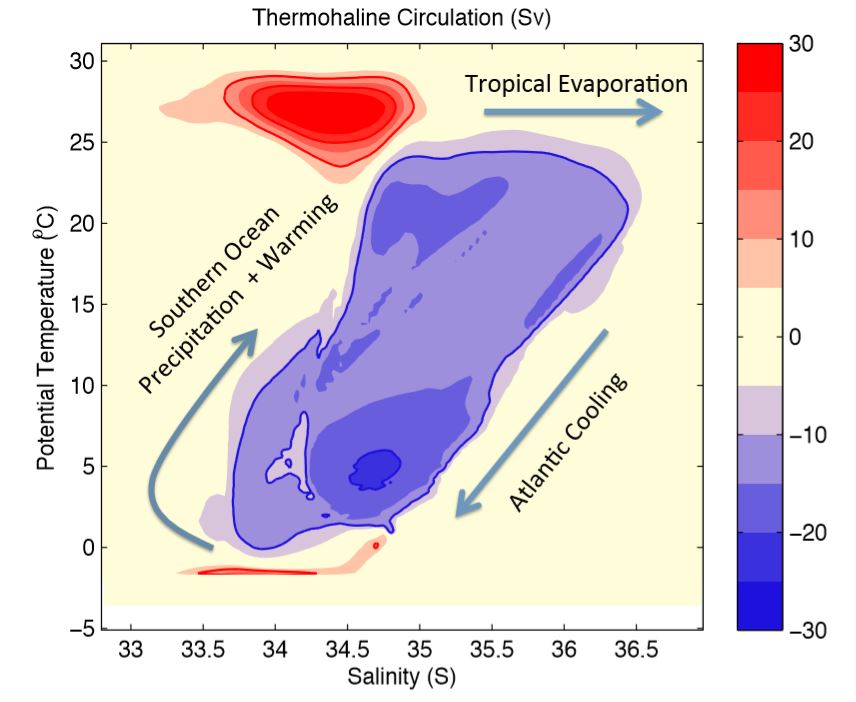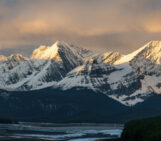
Geotalk is a regular feature highlighting early career researchers and their work. In this interview we speak to Jan Zika, an oceanographer at the University of New South Wales in Sydney, Australia. This year he was recognized for his contributions to ocean dynamics research as the winner of the 2018 Ocean Sciences Division Outstanding Early Career Scientists Award.
First, could you introduce yourself and tell us a little more about your career path so far?
My pleasure. I was actually pretty set on the geosciences as a kid. I think all my projects in my last year of primary school were about natural disasters of some form or another – volcanoes, earthquakes, tsunamis, etc. My teachers must have thought I was going to grow up to be a villain in a James Bond film.
I grew up in Tasmania, where there aren’t exactly natural disasters, but nature was very present in my everyday life and that sustained my interest into adulthood. When I was ready for university, meteorologists, geologists, and other researchers advised me to do the hard stuff first. So in my undergraduate degree I focused on mathematics and physics. I was good at it, but I kind of forgot why I was there at some point.
Things changed for me when I interned at a marine science laboratory in Hobart operated by the Commonwealth Scientific and Industrial Research Organisation (CSIRO). I’d walked past the building so many times growing up but never thought I’d get to work inside. Bizarrely, I worked on a project related to the Mediterranean Sea. It was just so uplifting being able to put all these skills I had learnt in class, like vector calculus and thermodynamics, into practice.
From then on I was properly hooked on oceanography and the geosciences. I got into a PhD program through the CSIRO, which felt like being drafted to the Premier League. After completing the doctorate, I took a job as a research fellow in Grenoble, France. Not an obvious place to study the ocean I know, but there was a great little team there. After a couple of years, I moved to the UK, first to the University of Southampton then Imperial College London.
After seven years as a research fellow in Europe I returned home to Australia to become, of all things, a mathematics lecturer at the University of New South Wales. My research is still related to oceans and climate, but day-to-day I am teaching maths. At least now when I teach vector calculus I can pepper the lectures with the sorts of applications to the natural world that have inspired me throughout my whole career.
This year you were awarded an Outstanding Early Career Scientists Award in the Ocean Sciences Division at the 2018 General Assembly for you work on understanding the ocean’s thermohaline circulation and its role in Earth’s climate. Could you tell us more about your research in this field and its importance?
I’d love to. In many fields of science just changing the way you look at a problem can have a big effect. Usually this involves drawing different kind of diagrams. These diagrams may seem abstract at first, but eventually they make things easier to understand. Some diagrams we are all familiar with in one way or another, such as the periodic table, Bohr’s model of the atom, and the economists’ cost-benefit curve. These were all, at some stage, new and innovative ways of presenting something fundamentally complex. I am not saying I did anything like make a model for the atom, but I was inspired by the work of 19th century physicists who made simple diagrams to describe thermodynamic systems (like engines and refrigerators, for example). I wanted to apply these types of ideas to the ocean.
Working closely with colleagues in Australia and Sweden, I came up with a way to make a new diagram for the ocean’s thermohaline circulation. This is the circulation that, in part, makes Europe relatively warm, and plays a big role in regulating Earth’s climate. The new diagram we developed helped us to understand the physical processes controlling the thermohaline circulation and opened the door to all sorts of new methods for understanding the ocean’s role in climate.

Jan’s diagram of ocean circulation in temperature-salinity coordinates from a global climate model (Community Earth System Model Version 1). Contours represent volumetric streamfunction in units of Sverdrups (1Sv = 10^6 m^3 s^-1). Credit: Jan Zika
I started to realize I had stumbled onto something really big when I ran the idea by a Canadian colleague Fred Laliberte, who was a researcher at the University of Toronto at the time. He had been working on a very similar problem in the atmosphere, and my diagram was just the thing he needed to work things out. We ended up getting that work published in the journal Science and we were able to say a thing or two about how windy the world might get as the climate changes. To know my ideas were having an impact well beyond my immediate research area really was special.
And what did you find out? How will climate change affect the world’s wind?
What we found was that overall the earth’s atmosphere won’t get much more energetic (or may even get less energetic) as the climate warms. This means that although extreme storm events may become more frequent in the future, weak storms may become much less frequent (more calm weather). One can draw an analogy with a spluttering engine: it produces bursts of energy when it splutters but is slower and less effective the rest of the time.
Your research pursuits have taken you to some pretty incredible places. What have been some highlights from your time out in the field?
It has been great to balance the mathematics and theory I do with research in the field. As an oceanographer I have been ‘to sea’ a few times. The most memorable was when I was part of a research project to measure in the Southern Ocean. Our research area was between South America and the Antarctic continent. We set off from the Falkland/Malvinas Islands and made our way around the Scotia Sea dropping by South Georgia on our way back. Those Antarctic islands had the most spectacular scenery I have ever seen. The highlight though was when a gigantic humpback whale spent a few hours playing with us and the ship – spinning under water, breaching and popping up to say hello.

Jan (right) with Brian King (left) from the UK National Oceanography Centre. Pictured here on the James Clarke Ross in the South Atlantic deploying an Argo Float. The instrument measures ocean temperature, salinity and pressure. Credit: Jan Zika
As part of the research, we released a small amount of inert substance (a type of chemical that wouldn’t affect marine life) about a kilometre below the surface of the ocean. This is called a ‘tracer.’ The idea was we would let the ocean currents move and stir the substance like milk poured into coffee. It is really important for us to understand how much things mix in the deep ocean as this affects the thermohaline circulation and how heat and carbon are absorbed into the ocean with global warming.
Once we had released the substance it wasn’t that easy to find where it had gone. What we had to do was float around, drop over an instrument that could trap water at different depths, then bring the water samples to the surface and analyse them in a small lab we had on board. The difficult part was the tracer would become really dilute once it had been mixed by ocean currents, and it was both a really time consuming and costly process to collect and analyse the substance. So we had to exploit sophisticated computer models and pool all our knowledge and best guesses on where the tracer might have gone. We did such a good job tracking it that we were able to continue gathering oodles of valuable data for almost twice as long as had originally been planned. This was testament to the excellent teamwork and ingenuity of our collaborators at sea, in the lab and in front of computers.
Outside of research, you have also been involved with a number of science communication initiatives and outreach activities with young students. What advice would you impart to scientists who would like to engage with public audiences?
That is right, I really enjoy inspiring the next generation and getting non-science folk engaged in what we do. I would say that you want to simplify things but don’t dumb them down. I’ve learnt the hard way that even when speaking to other ‘experts’ it is best to use plain language instead of jargon and go slowly through concepts even if you feel they should be basic. I think working with people from around the world (e.g. in France) who don’t have English as a first language, really helped me with this.

Jan teaching a Geophysical Fluid Dynamics class at the University of New South Wales with the aid of a rotating tank experiment. Credit: Susannah Waters
At the same time I am always surprised at how quickly young students can absorb ideas and throw up questions that even an expert wouldn’t have come up with. The great thing is that your students aren’t wedded to dogma like experienced researchers are, and so are capable of much more creative ideas.
The other day I was helping with a special event to encourage females to enter mathematics. I was inspired by a talk given by the Australian Girl’s Maths Olympiad Team who had just competed in Venice. They said solving Maths Olympiad problems was all about breaking down a big problem into smaller problems they already know how to solve. I ended up changing my own talk as I was inspired by this theme.
I guess what I am suggesting is, if you are organising outreach activities, instead of thinking about how to ‘tell them’ how things work, think about ways to get ideas from them. Include them in the process. Ask them the hard questions. That way everyone will be much more involved. And who knows, it might spark a great idea.
Interview by Olivia Trani, EGU Communications Officer




